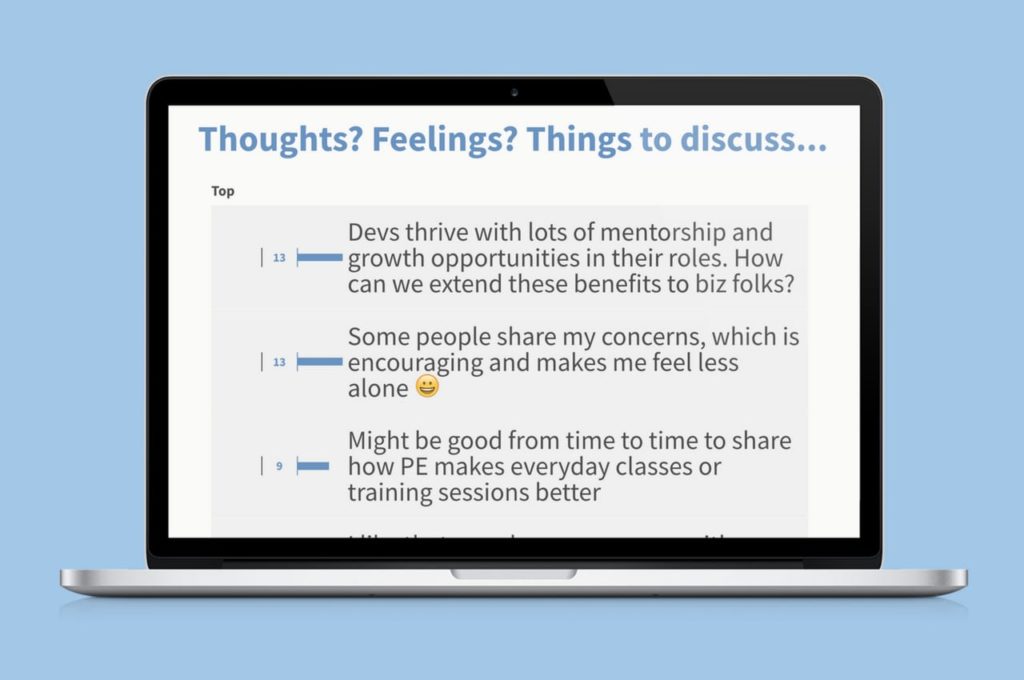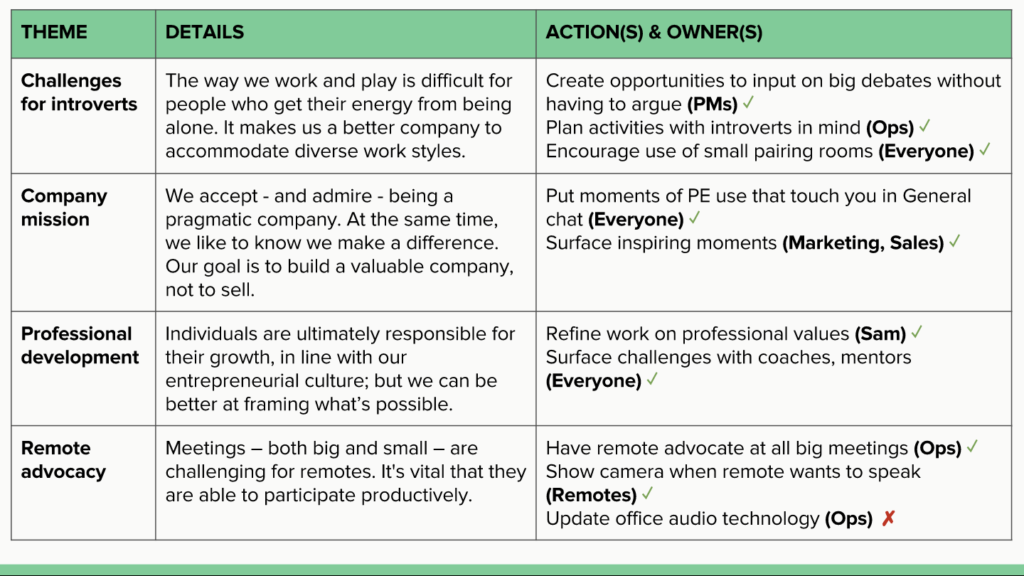How, when, and why Poll Everywhere does employee satisfaction surveys
Seismic shifts in the workplace landscape have brought employee satisfaction — often conflated with employee engagement — front and center in the modern workforce.
Employee engagement is an important metric: according to Gallup, companies with engaged employees significantly outperformed those with disengaged employees in profitability, productivity, and quality defects (to name a few).
So engagement can be a litmus test for the overall health of your organization when measured quantitatively.
As Gallup states, “Work units in the top quartile in employee engagement outperformed bottom-quartile units by 10% on customer ratings, 22% in profitability, and 21% in productivity. Work units in the top quartile also saw significantly lower turnover (25% in high-turnover organizations, 65% in low-turnover organizations), shrinkage (28%), and absenteeism (37%) and fewer safety incidents (48%), patient safety incidents (41%), and quality defects (41%).”
The difference between engagement and satisfaction
Employee satisfaction is a different beast. It is a fairly amorphous concept, that has not been as clearly defined nor as rigorously researched as employee engagement.
Employee satisfaction reflects the past. You do work and then sit back and feel “satisfied.” Or you feel “unsatisfied.” It suggests passivity which is at odds with productivity – and ultimately, the joy you could find in your work.
Engagement is about how you approach your work and then how you do the work. It is much indicative of how productive you can be and the standards of quality you may be able to meet. It reflects that you care. You can be unsatisfied, yet deeply engaged.
Read on for a full account of how Poll Everywhere uses employee engagement measurements to prioritize its people efforts, and get access to a downloadable CSV of the questions we use that you can import to your own account.
Poll Everywhere employee engagement surveys
“The live Q&A with our COO is a special experience at Poll Everywhere. It’s authentic, it’s unfiltered, and it is truly impactful.”
— Poll Everywhere People Ops Manager Thoey Bou
Step 1: Send out an anonymous survey link
Twice a year, the Poll Everywhere Ops team sets up an anonymous employee engagement survey (similar to an employee satisfaction survey, but not exactly.) The questions are informed by research from Gallup on employee engagement, with some minor tweaks to make it our own. “Gallup’s questions were short and sweet,” Bou said, “but our employees wanted to go deeper and give more longform feedback.”
In other words, Bou modifies the questions designed to measure employee engagement. The resulting questions encourage more thoughtful responses that speak to how each employee experiences Poll Everywhere as a company.
“We adapt to the needs of our employees,” Bou continued. The precise mixture of 19 multiple-choice and open-ended questions is then sent out to employees using the shareable response link.
Anonymity is crucial, so anonymous responses is always enabled for these surveys. Employee satisfaction surveys are only useful to the degree that they paint an accurate portrait of the employee experience, so that you can act on any areas of concern. That accuracy requires honest answers, and honest answers require that employees feel safe, comfortable, and supported in speaking up.
That said, employees also know that to achieve true transparency, their responses will be shared with the rest of the company so they can be discussed in the open air. That being the case, everyone is encouraged to submit responses that don’t contain information that might be used to infer their identity.
Related: The 9 questions that uncover the most surprising insights from employees
Step 2: Discuss results live with the entire company
The cornerstone of the entire process is the discussion that follows. This is where the insights are.
The Ops team kicks things off by handing out an executive summary report containing all responses to each question. There is no editing of the responses. There is no shaping. The pre-read gets everyone on the same page, and establishes trust in the transparency of the process.
“When people realize others share their excitement or concern, that’s a great feeling. Camaraderie spreads throughout the company, and reminds us that we all carry these emotions inside us.”
— Thoey Bou

Next, Ops opens a Poll Everywhere Q&A, where everyone submits their questions and reactions to the survey responses.
Poll Everywhere’s Q&A activity lets people submit questions and feedback anonymously using their phones or laptops. Those response appear live in real time for everyone to see (and upvote, if they agree). COO Sam Cauthen then talks through the entire list of reactions and questions one item at a time, from the most upvoted to the least.
“From a leadership perspective, it’s very risky, but we do it this way because we value transparency. It shows that we have confidence in ourselves, and we want that to be felt by the rest of the company.”
— Thoey Bou
This level of transparency is vital to the integrity of the entire process. Concerns are discussed in the moment, and employees get to see how their feedback directly influences decisions about how Poll Everywhere operates.
Step 3: Identify themes and assign action items
With the survey and Q&A results in hand, Operations can start their analysis.
“We tie each piece of feedback to a theme,” explained Bou. “That helps us determine, ‘Oh! These are the things people care about because they came up a lot.’ We can’t respond to individual concerns — because the survey is anonymous — but we can respond to themes, like a widespread desire for more frequent performance feedback. After that, we decide, ‘What’s the action item?’ and ‘Who’s the owner?’”

“Everyone on the Operations team feels highly motivated to work on these goals,” added Bou. “We’ve never had to set a deadline or crack down on people for this. Each person can clearly see how this work ties back to the greater concerns of the company.”
Six months later, when the next employee satisfaction survey launches, the Ops team shares results from the action items synthesized from the last survey. The bi-annual cadence serves as a deadline for executing these action items. It displays quick responsiveness to feedback, while also providing employees with more opportunities to voice their opinions.
According to Bou, “Everyone here feels motivated to give thoughtful, detailed feedback because they know — they can see — how the Ops team will follow-up and do something about it.”
Related: Quit measuring employee engagement
19 questions for your employee satisfaction survey
Employees are increasingly looking to work for personal fulfillment. Traditional management techniques rely on a straightforward formula to improve company health: the greater the compensation, the greater the incentive, and the greater the incentive, the better the employee performs.
That formula simply doesn’t hold in today’s changing work landscape. In fact, the single most important factor in job satisfaction, according to a 2017 Society for Human Resource Management survey, is “respectful treatment of all employees.” Compensation is still an important piece of the puzzle — people still need to eat — but other, less quantifiable factors are on the rise:
- Psychological safety
- Opportunities for growth
- Company mission or purpose
- Camaraderie with colleagues
- Trust and communication between workers and management
To tackle these beefy questions in your own company, enter your email below to download a CSV of Poll Everywhere’s own employee satisfaction survey questions. In the email that follows, I’ll include instructions on importing the questions to your own Poll Everywhere account in just a couple of clicks. I’ll also share a five tips from Poll Everywhere’s Ops team to make this employee satisfaction survey a success.